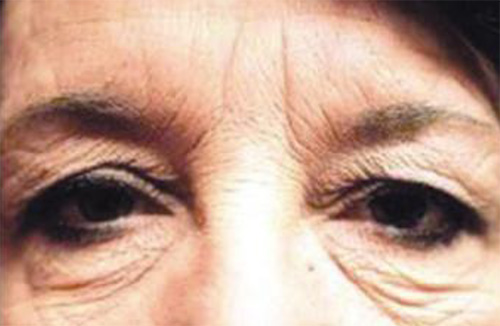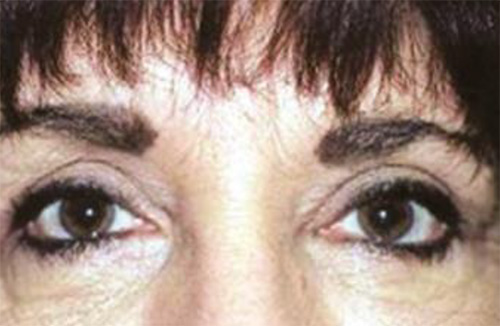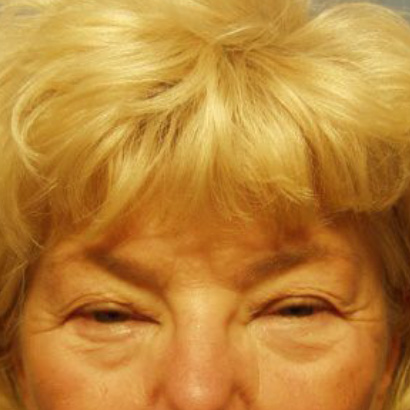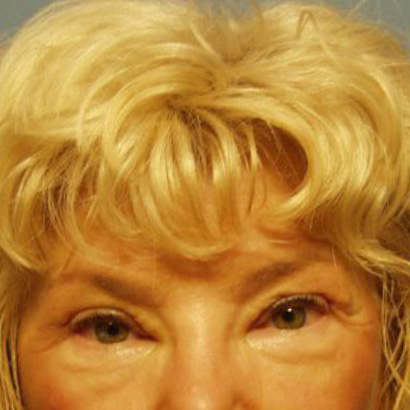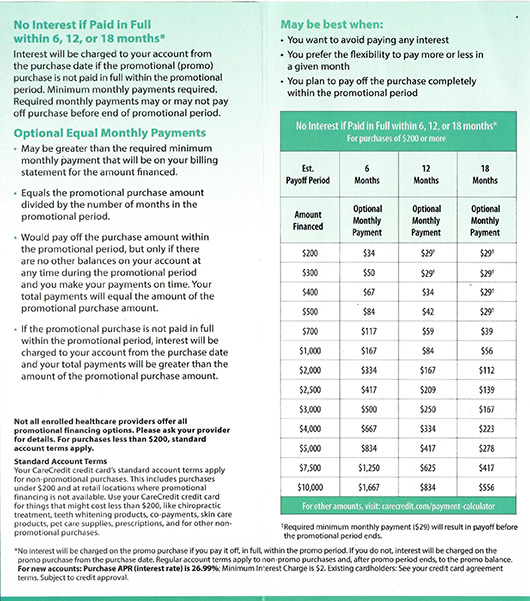As an artist and a surgeon, Palm Beach Plastic Surgeon Dr. Anita Mandal takes great care to restore youthful eyelid contours that are, most importantly, natural looking. Patients travel from all over Florida, across the country, and around the world for Dr. Mandal’s expertise in blepharoplasty. She is one of the top plastic surgeons for eyelid beautification. Dr. Mandal spends extra time to precisely mark incision lines as a crucial step in giving a rested, refreshed upper face and avoiding an over-pulled, surprised look from blepharoplasty. Dr. Mandal also performs 99% of her blepharoplasties with local anesthesia in her office surgical suite, significantly reducing the recovery and risks of surgery.
Your eyes are the first thing that people notice when they look at your face. Because they also are one of the first areas to age, eyelid surgery is often a very rewarding part of the facial rejuvenation process. Located in Palm Beach Gardens, Dr. Mandal provides eyelid surgery for patients in West Palm Beach, Palm Beach Gardens, and all over south Florida.

Best Candidates for Blepharoplasty
- Loose or excess eyelid skin
- Protruding fat bags of the eyelids
- Low pre-operative risk factors
- Realistic expectations
- Overall good health
- Good skin elasticity
Aging of the Eyelids
Eyelid fullness can be noted as early as one’s 20’s and 30’s. When present at a young age, it is often due to genetics and consists of bulging fat. As you age into the ’40s and ’50s, the eyelid skin loses elasticity and becomes lax, creepy, and wrinkled. The fibrous tissue that supports the fat compartments inside the orbit(eye socket) also loosens, causing the orbital fat to protrude and appear as bulges or bags around the eyes. “Eye bags” are common in the inner corner of the upper eyelids, the outer corner of the lower eyelids, and along the central upper and lower eyelids. These changes can give a tired, sad, or angry look to the face. The eyes can even appear smaller, slit-like, or droopy. Since everyone ages differently, heaviness above the eyes is sometimes due to sagging eyebrows rather than aging upper eyelids. Dr. Mandal can determine the proper cause of your eyelid fullness and tailor treatment to your specific needs.
Male Vs. Female Blepharoplasty
Distinct differences exist between the male and female eyelid. Dr. Mandal’s approach to blepharoplasty takes gender differences into consideration when performing blepharoplasty. Her goal is to preserve the natural masculine vs. feminine appearance of the eyelid.

Female Eyelid
- High set brows
- Well-defined brow arch
- More visible upper eyelid height
- A deeper upper lid crease
- Thinner eyelid skin

Male Eyelid
- Low set brows
- Flatter brow arch
- Less visible upper eyelid
- More shallow upper lid crease
- Thicker eyelid skin
One of the most common mistakes made by many plastic surgeons is to feminize the male upper eyelid. A male upper eyelid retains its more natural, masculine appearance when slightly less skin is removed and more fat padding is left intact. A tight upper eyelid with a deep upper lid crease or high arched brow will give a man a more feminine appearance to the eyelids.
On the other hand, because women have thinner eyelid skin, it is important to sculpt the outer corner of the upper lid where one can be more aggressive with skin removal to reduce the lateral hooding or overhang to minimize the appearance of a sad or droopy outer eyelid. At the same time, too much fat should not be removed in the central part of the upper eyelid to avoid hollowing which can give the female eyelid a gaunt, more aged look.
Natural, youthful eyelid rejuvenation that respects inherent gender differences is best performed by a Board Certified Facial Plastic Surgeon who specializes in the face. Dr. Mandal has a detailed understanding of male and female surgical eyelid anatomy, a high level of technical expertise, and over 20 years of experience to achieve the desired eyelid rejuvenation for her patients.
Palm Beach Blepharoplasty
Palm Beach eyelid surgery, also known as blepharoplasty, is a surgical procedure in which loose skin, protruding fat, and/or muscle is removed from the upper and/or lower eyelids. There are several surgical approaches to eyelid lift surgery, depending on each person’s unique aging as well as the amount of fat and/or skin to be removed.
Upper Eyelid Surgery (Upper Blepharoplasty)
The aesthetic goals of upper eyelid surgery are to reduce lid fullness, make the lid more visible and add depth as well as definition to the natural upper eyelid sulcus. The incision is well hidden in your natural upper eyelid crease. Excess skin and bulging fat are then removed. The incision is closed with a very fine suture with the placement of subcuticular stitches which are taken out in 3 – 5 days. The final result reveals a more youthful, refreshed, and rested appearance.
Lower Eyelid Surgery (Lower Blepharoplasty)
The aesthetic goals of lower eyelid surgery are to smooth out wrinkles, remove excess skin and flatten bulges without hollowing the lower eyelid area. Surgery is performed using various methods, the choice of which depends on the degree of skin and/or fat removed. Unlike an upper eyelid lift, the incision site in lower eyelid surgery varies with the patient and, in large part, depends on whether the skin is to be removed.
Pinch Blepharoplasty
This lower eyelid procedure can reduce excess, lax, or wrinkled eyelid skin. It is important to note that pinch blepharoplasty is not intended to completely flatten or tighten the lower lid. It involves excising an ellipse of eyelid skin without entering the deeper muscle layers. Pinch blepharoplasty is a conservative upper or lower eyelid lift in which some, not all, of the laxity and wrinkles of the lid are improved to give modest eyelid tightening. There is a less overall disruption to the eyelid tissues, thus reducing the typical risks of lower eyelid surgery. The results reveal a more modest, natural improvement. Like all cosmetic procedures, patients must have realistic expectations when considering pinch blepharoplasty.
Standard Lower Lid Blepharoplasty
The standard lower eyelid lift is designed for patients with more significant loose skin and/or bulging fat of the lower eyelids. Compared to pinch blepharoplasty, a standard blepharoplasty incision is longer, yet still well hidden just under the lower eyelash line. Skin and underlying muscle are elevated together as a flap to access bulging fat which is removed. Excess skin and muscle are also excised. The incision is closed with very fine sutures. The stitches are removed 3 to 5 days later.
Transconjunctival Blepharoplasty
This lower eyelid lift is ideally suited for patients who primarily have bulging fat with no significant loose or excess skin. Unlike the skin incisions seen in a pinch and standard blepharoplasty, the transconjunctival incision is placed inside the eyelid, well hidden within the conjunctiva. The eye itself is protected during surgery. Because the incisions are internally placed, there are no sutures to remove and no external, visible scars. Eyelid muscle integrity and overall lid support are also better preserved. Transconjunctival blepharoplasty is not only very safe but allows for fat removal without entering or disrupting the skin, muscle, and fibrous support layer of the lower eyelid. This procedure can effectively reduce eyelid “bags” with less tissue disruption, lower risk, and faster recovery.
Combined Transconjunctival and Pinch Blepharoplasty
Sometimes, transconjunctival lower lid blepharoplasty is combined with a pinch blepharoplasty of the upper eyelids when excess skin and fat bags are both present. One must be realistic and expect a modest improvement.
Combined Upper and Lower Lid Blepharoplasty
People often age simultaneously in both their upper and lower eyelids. In such cases, both upper and lower lid blepharoplasty is performed at the same time.
Browlift
Many of our Palm Beach Gardens & West Palm Beach eyelid surgery patients actually need a brow lift. Sometimes, upper eyelid fullness is mainly due to sagging eyebrows rather than excess skin and fat of the actual eyelid itself. A plastic surgeon with keen judgment recognizes this presentation and may recommend a browlift as the treatment of choice as opposed to an upper eyelid lift.

Where are the Incisions placed?
Prior to surgery, the upper and lower eyelid skin is precisely marked with the patient sitting upright since the eyelid tissues shift position when the patient lies flat for surgery. This key step can avoid an overpulled or unnatural result. The patient is also asked to look in different directions to identify hidden fat pockets which must be removed during surgery to avoid fat protrusions post-operatively.

Incisions are hidden in the natural upper eyelid crease and closed with very fine sutures to assure a successful outcome.

Sutures are typically removed 3 to 5 days postoperatively. Incisions can be easily camouflaged with makeup until they fade. Dr. Mandal recommends the aggressive use of saline eye drops and lace-lube ointment postoperatively to keep the eyes well-lubricated until postoperative swelling subsides.

Technical Expertise With An Artistic Eye
Surgical skill combined with an aesthetic eye is a key part of achieving satisfying eyelid results for our Palm Beach eyelid surgery patients. Dr. Mandal gives special attention to specific details for a rested, natural eyelid:
- Placement of incisions in very specific locations, making the scar unnoticeable once healed
- Preoperatively marking eyelid incisions with the patient in a sitting position to assure removal of very precise amounts of skin to reduce the chances of a “surprised” look and eyelid closure problems
- Use of very fine sutures with a special suturing technique to enable more rapid healing of incisions
- Use of local anesthesia, whenever possible, to reduce recovery and overall risk
- Attention to lateral hooding of the upper eyelid to improve sad or droopy outer eyelids. Most surgeons fail to extend the upper lid incision properly
- Careful removal of only the necessary amounts of fat to prevent a hollowed appearance to the eyelid
- Identification of hidden fat pockets to avoid fat protruding after surgery
- Recognizing when a browlift is needed instead of an eyelid lift
- Advising additional procedures for an overall balanced facial appearance
Pre-operative Risk Factors
While our Palm Beach blepharoplasty is a very safe procedure, certain pre-operative conditions may increase the risks from blepharoplasty:
- Frequent or regular dry, irritated, or watery eyes
- A loose lower eyelid that does not snap back after being pulled away from the eyeball
- Scleral show (the white area of the eyeball between the lower lid and the pupil edge is more visible than average when looking straight ahead)
- Bulging or protruding eyeballs (proptosis or exophthalmos)
- Certain types of glaucoma
- Smoking
- Poor health
These risk factors are not necessarily absolute contraindications to blepharoplasty, but they should be taken into strong consideration. A personalized consultation with Dr. Mandal can provide you with a thorough understanding of whether you are a candidate for blepharoplasty and what it can do for you. Dr. Mandal tailors the choice of eyelid and brow procedure to your lifestyle and individual needs.
Downtime & Recovery
Getting Eyelid surgery or blepharoplasty in Palm Beach Gardens by Dr. Mandal is an outpatient procedure. After surgery, patients are discharged to the comfort of their own homes. There are no postsurgical dressings. Because the eyelid skin is thin, bruising and swelling are to be expected but are typically minimal after one week, and easily concealable with makeup.
Expedite Your Healing
- Application of naturally-derived topical healing factors intra-operatives
- Head of the bed elevation
- Application of ice for 48 hours
- Book 2-4 manual lymphatic massage treatments
- Aggressive application of saline eye drops and eye-lubricating gel
Bruising and swelling do not correlate with pain as most patients experience minimal discomfort after eyelid surgery. While prescription pain medication is given, most patients switch to plain Tylenol or stop all pain medications within 1-2 days after surgery. Sutures are removed between 3 and 5 days postoperatively. Typically, patients feel comfortable being seen in public for one week. Most can also return to non-exertional activities at this time. Straining, lifting, and strenuous activity should be avoided for at least several weeks. Once healed, a more refreshed, youthful eyelid contour which can take 5-15 years off your face is revealed.
Anesthesia
Dr. Mandal performs most of her upper and lower eyelid surgery with local anesthesia in her Palm Gardens surgical suite. Using advanced local anesthetic techniques, the patient is awake during the entire procedure but feels no pain. Oral sedatives are prescribed during surgery if needed. While blepharoplasty can also be performed with general anesthesia or intravenous sedation, also known as “twilight sleep”, more aggressive anesthesia is reserved for special situations. The use of local anesthesia not only reduces patient risk but is also more cost-effective.
Types of Anesthesia
- Local anesthesia – lowest risk, quickest recovery, shortest operating room time
- Twilight sleep or IV sedation
- General anesthesia
Additional Procedures
Additional procedures commonly performed to complement or enhance the results of blepharoplasty include:
- Botox® Cosmetic, Dysport®, Jeuveau™, and Xeomin® for frown lines between the brows, laugh lines or crows feet around the eyes, wrinkle bunching under the eyes, and forehead lines
- Laser resurfacing or chemical peels for fine lines around the eyes
- Injectable fillers such as Restylane® and Bellafill®, the 5-year filler, fill tear trough hollows under the eyes and improve dark circles
- Sculptra®, Radiesse®, Restylane®, Juvéderm®, RHA® Collection, or Bellafill® for temple depressions to make the eyes appear more awake
- Genius™ RF /Infini™ RF Non-surgical Brow Lift to improve upper eyelid fullness due to heavy eyebrows
- Surgical Brow or Forehead Lift to improve upper eyelid fullness caused by sagging brows rather than excess eyelid skin
Frequently Asked Questions
Dr. Mandal’s goal is to restore your natural youthful eyelid contours, rather than make you look totally different or surprised. She believes in making you look like yourself but a more youthful version. Blepharoplasty can take years off your face, giving a more rested, refreshed and awake look. Dr. Mandal uses a specific surgical approach to help prevent an unnatural or “surprised” result.
It has been scientifically established that smoking negatively impacts wound healing. Smoking causes the smaller blood vessels to shrink, thus preventing oxygen and nutrients from getting to the tissues. While smoking is not an absolute contraindication to eyelid surgery, it does increase the risks of infection, tissue necrosis and poor healing. If you are a smoker, Dr. Mandal will take your smoking history into consideration when advising you on your options.
The final scar is well hidden in the upper sulcus for upper lids and just below lash line for lower lids. The scars gradually fade from pink to white, ultimately blending with the surrounding skin color over months. In most patients, however, the scars are barely noticeable after a few weeks.
As is true for any surgery, bleeding, infection, scarring and unsatisfactory result are general risks. Specific risks include, but are not limited to, visual impairment, eversion or inversion of the eyelid margin, milia (tiny cysts along the suture line) and dry eye syndrome. When performed on the right patient, by a skilled surgeon, the overall risks of having problems after blepharoplasty are very low.
Facial cosmetic procedures have become increasingly popular among men. National statistics show that blepharoplasty is one of the most popular cosmetic surgeries in men. While the ultimate goal of blepharoplasty is the same for men and women, the approach in men is slightly differently. A lower set eyebrow and some heaviness of the upper eyelid are a male beauty standard. When performing blepharoplasty, Dr. Mandal leaves a mild to moderate amount of heaviness in the upper lid area to maintain a masculine eyelid contour.
The best age for blepharoplasty varies with the patient, ranging from the early 20’s into one’s 80’s. Most patients seeking blepharoplasty in their 20’s and 30’s are often born with protruding fat as a congenital issue. Mature patients have developed skin laxity and/or fat bulging with age, making them a candidate for blepharoplasty as well.
Yes! It is not uncommon to undergo blepharoplasty more than once. It all depends on the pace at which you age and everyone ages differently. In fact, some patients have had eyelid surgery several times over a span of decades. The decision to have secondary blepharoplasty is best made through careful consultation with your facial plastic surgeon to assure the best results.
Dr. Mandal most commonly performs blepharoplasty under local anesthesia. The use of general anesthesia and IV sedation is limited to those patients who are not candidates for local anesthesia.
While a browlift can be performed at the same time as blepharoplasty, one has to be careful so that the results of one procedure do not interfere with the other.
The laugh lines or crows feet on the outside of the eyes are not a surgical problem and are typically treated with Botox® or Dysport®. Heavy wrinkles under the eyes are sometimes improved with eyelid surgery, but finer lines and creepy skin may require a chemical peel or laser resurfacing.
Both procedures are lower eyelid lifts. Standard lower lid blepharoplasty entails making an incision on the outside with removal of skin and sometimes fat. In transconjunctival blepharoplasty, the incision is hidden on the inside and no skin is removed as this procedure is only for fat removal. Transconjunctival blepharoplasty is the most common type of lower eyelid performed by Dr. Mandal.
Yes and No! It depends on what is causing the dark circles. When dark circles are the result of shadows caused by bulging lower eyelid fat, then fat removal can improve dark circles. In cases where dark circles are due to hollowing of the lower eyelid area, blepharoplasty can actually worsen dark circles. A better option is the use of Injectable fillers such as Restylane or Bellafill which can effectively fill the hollows, improving the dark circles. When dark circles are solely the result of skin discoloration, neither surgery nor fillers are indicated but skin lightening treatments may help.
Dr. Mandal commonly performs Injectable fillers, Botox®, Dysport®, mini-facelift, WhisperLift™, Genius™ RF / Infini™ RF, rhinoplasty and facelift in conjunction with blepharoplasty.
As a Board Certified Facial Plastic Surgeon, Dr. Mandal focuses on satisfying results that are very natural looking. When it comes to the face, patients prefer quality and excellence over price. They seek her skills from throughout Palm Beach County, across Florida and a range of national and international locations. To discover your options, request a consultation online or call 561-238-0040 at our Palm Beach Gardens office.

